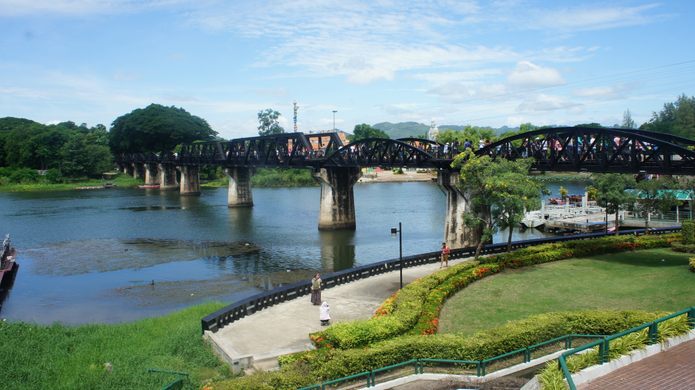AO Edited
Death Railway Bridge
This bridge made famous in a novel and on-screen wasn't actually built over the river Kwai.
There is a famous bridge in Thailand that crosses a river called the Khwae. It’s a destination for visitors of all kinds, including Europeans and Americans—who mostly have no idea they’ve been mispronouncing it for over 60 years.
The river under the famous crossing is known to most westerners as the “Kwai,” thanks to the 1952 novel and 1957 movie version of The Bridge Over the River Kwai. The specific plot and characters are a fiction, but the underlying story is true, and the 500-foot span has become Thailand’s most visible and poignant remnant of a brutal chapter of World War II.
The bridge is in the quiet, provincial town of Kanchanaburi, about 30 miles east of the Myanmar border. It was constructed during the War as part of the Thailand-Burma Railway, a transport system that came to be known as the “Death Railway,” its dark history bloodied by the nearly 100 thousand forced laborers and 16,000 prisoners of war who lost their lives during its construction.
The historic bridge is a symbolic reminder of the harrowing cruelty suffered by the Allied POWs (some American, the majority English and Dutch) and the conscripted Southeast Asian laborers, all forced into service by the Japanese. The intent was to build a 250-mile railway as a supply route from Ban Pong in Thailand to Thanbyuzayat in Burma (now Myanmar). A project estimated to take up to five years was forced to completion in 16 months, and with it came unrelenting brutality, rampant disease, squalid conditions and workers’ rations barely above starvation.
The bridge served its intended purpose for less than two years, when the railway was heavily bombed by the Allied forces in 1945. What was intended as a line to supply Japan and its plans to conquer further west, instead becoming an escape route for retreating Japanese troops. Control of the railway was divided between the British, who took the Burmese side, and the State Railway of Thailand (SRT), who took the Thai side and what remained of the bridge.
Although the stories of the novel and movie were inventions of Pierre Boulle and Hollywood, the bridge itself was an important part of the railway—it just didn’t happen to cross the Kwai (or Khwae, which is pronounced more like “kware”). There was no bridge over the Khwae—Boulle simply got his rivers mixed up. It’s the right bridge, but the river is the Mae Klong. So rather than change minds over the mistake, the government of Thailand simply changed the name of the river in 1960, rechristening this stretch as the Khwae Yai.
The Bridge over the River Khwae Yai suffered heavy damage in the bombing, taking out all but the outer steel structure. It was rebuilt by the SRT, and has since been used for commercial and tourist travel. You can cross by rail car, or see this piece of history up-close on foot.
Know Before You Go
Kanchanaburi is about 75 miles northwest of Bangkok, and there are bus routes from Northern and Southern terminals (Mo Chit and Sai Tai Mai), and from Victory Monument. There are also busses from the nearby towns of Ratchaburi and Suphanburi. Travel by train is on the Bangkok Noi - Nam Tok line, and there are also packaged day trips from Bangkok to the Bridge and surrounding memorials and other World War II sites (e.g., the Allied War Cemetery, the Thailand-Burma Railway Centre Museum, and the JEATH War Museum). In the last week of November and the first week of December, sound and light shows commemorate the Allied forces attack on the Death Railway, and big crowds descend – so at this time in particular, plan your trip well in advance and book ahead to secure travel and accommodations. For the fictionalized version, the 1952 novel by Pierre Boulle is still in print, or you can check out the 1957 movie with William Holden and Alec Guinness.
The Atlas Obscura Podcast is Back!























Follow us on Twitter to get the latest on the world's hidden wonders.
Like us on Facebook to get the latest on the world's hidden wonders.
Follow us on Twitter Like us on Facebook